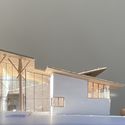
We deal with buildings every day. We sleep in them, work in them, live our lives using their accommodation. But like a song or a painting, a person usually helps create them, with those who use and build them, then the world receives that work. But before they are built, buildings are just ideas.
Ideas are not selected, they are formed. But to be realized by the designer and the user, these ideas need to be understood, their flaws revealed and their opportunities realized. In this generation, the 3D world of paper and books and, well, offices, has given way to the faster, cheaper, easier 2D work of using electrons – culminating, in many things, to become “Virtual Reality” – VR.

In my freshman year of architecture school in 1974, Scientific American thrilled everyone by showing I.M. Pei’s Johnson Art Museum at Cornell, built down the Quad walkway from my adviser Don Greenberg’s office. Greenberg had virtually discovered the brave new world of computer rendering. That breakthrough made those midcentury models antiques within a generation.

Architects may revel in the safety of virtual buildings, but building goes beyond creating. To create, you have to sell the virtues of what is designed to the client, the government, the funders, often the community. The desire for love extends into everything we market, and the value of VR is exquisite when an image is offered that anyone can see themselves in. A large and growing cottage industry of renderers are flooding everyone’s inbox with unceasing business solicitations. But there is a cost.
The stark realities of computer-driven drawing on a screen have gone beyond presentation and are a tool for design. 2D VR rendering has evolved to simulate reality with a quality that evokes and encourages an aesthetic that is at once exquisitely controlled and antiseptic.

This way software presents designs has a direct parallel to the way early 20th century photography transformed how everyone perceived buildings. The pristine, timeless clarity of black-and-white images soon found their way into real-time constructions. The 2d became 3D, then realized a near euphoric new reality in buildings than transcended the materiality of construction, and manifest the abstraction of fine art.
Something is also incomplete in the VR seduction. The human touch, the control of that touch, is both intimate and universal. The infinite reality of the sculptor’s maquette found in an architect’s model is simultaneously a search for and a test of ideas, and the most human of marketing methods. The ripping, cutting, gluing and taping are a direct brain-to-hand-to-material-to-reality connection: tangible, physical, real. This is not a method of presentation. It is a tactile way of thinking and looking that no sketch or screen can come close to equaling.

Architecture can be public or esoteric. But buildings are inevitably and unavoidably human experiences. VR is only human in our eyes and mind. The reality of space, shape, scale is simulated on our screens, often beautifully so, and if design is about making imagery and detached aesthetics, then photos and pixels are enough. But if design is intended to result in a physical creation in this temporal and experiential world, then physical models, perhaps handmade models, have fundamental value.

I started out working in the human mess and chaos of a woodworking shop, before CNC machines changed everything. That mess was directly reflected in the adjacent architecture office of Louis Mackall, my mentor and co-owner of the shop. The messy ethos of that shop infused our office. The instant physical exploration of ideas—with quick cutting and gluing of cardboard, paper, foamcore, and wood, spiced with plasticine clay, paint, or bits of clear plastic and metal—provided a primal joy for the designer and user that no screen can ever capture.

This article is part of the ArchDaily Topics: The Future of Architectural Visualizations, proudly presented by Enscape, the most intuitive real-time rendering and virtual reality plugin for Revit, SketchUp, Rhino, Archicad, and Vectorworks. Enscape plugs directly into your modeling software, giving you an integrated visualization and design workflow.
Every month we explore a topic in-depth through articles, interviews, news, and projects. Learn more about our ArchDaily topics. As always, at ArchDaily we welcome the contributions of our readers; if you want to submit an article or project, contact us.












